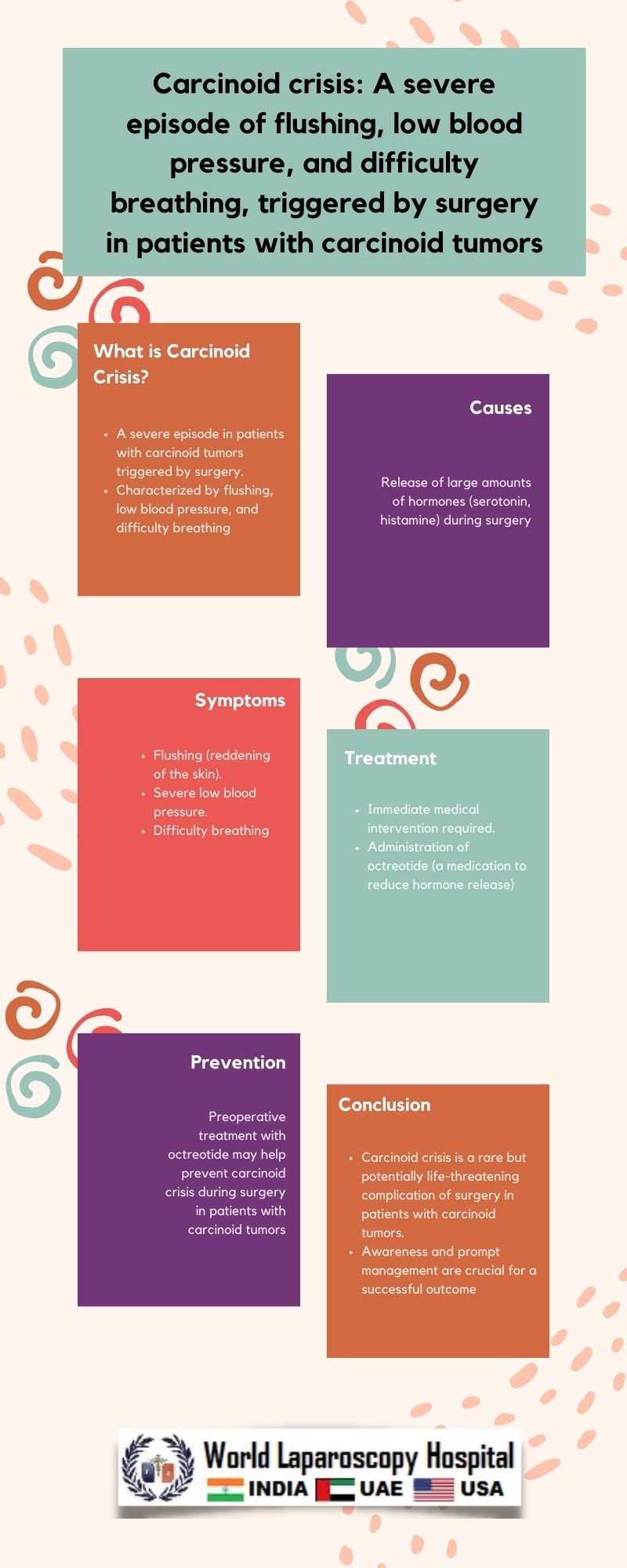Carcinoid crisis: A severe episode of flushing, low blood pressure, and difficulty breathing, triggered by surgery in patients with carcinoid tumors
Introdcution
Carcinoid tumors, although rare, can present significant challenges to patients and healthcare providers. One of the most serious complications associated with these tumors is the carcinoid crisis. This crisis is characterized by a sudden and severe episode of symptoms, including flushing, low blood pressure, and difficulty breathing, which can be triggered by various factors, such as surgery. Understanding the nature of carcinoid tumors, the mechanisms underlying carcinoid crisis, and the strategies for managing this condition is crucial for healthcare professionals involved in the care of these patients.

Carcinoid Tumors: An Overview
Carcinoid tumors are a type of neuroendocrine tumor that arises from the neuroendocrine cells, which are specialized cells found throughout the body, particularly in the gastrointestinal tract and lungs. These tumors can be either benign or malignant and are known for their ability to produce various hormones and bioactive substances, such as serotonin, histamine, and bradykinin. The excessive release of these substances into the bloodstream can lead to a range of symptoms, including flushing, diarrhea, wheezing, and heart palpitations, collectively known as carcinoid syndrome.
Carcinoid Crisis: A Life-Threatening Complication
Carcinoid crisis is a rare but life-threatening complication of carcinoid tumors. It is characterized by a sudden and severe episode of flushing, low blood pressure (hypotension), tachycardia (rapid heart rate), and bronchospasm (difficulty breathing). The exact mechanism underlying carcinoid crisis is not fully understood, but it is believed to be triggered by the release of vasoactive substances, such as serotonin, into the bloodstream, leading to a systemic inflammatory response and cardiovascular collapse.
Triggers of Carcinoid Crisis
Carcinoid crisis can be triggered by various factors, including:
Surgery:
Surgical manipulation of the tumor or anesthesia can stimulate the release of vasoactive substances, triggering a carcinoid crisis.
Embolization:
This procedure, used to block the blood supply to the tumor, can also trigger a crisis.
Biopsy:
The act of taking a biopsy of the tumor can lead to the release of vasoactive substances.
Stress:
Emotional or physical stress can sometimes trigger a crisis in susceptible individuals.
Clinical Presentation of Carcinoid Crisis
The symptoms of carcinoid crisis can vary in severity but typically include:
Flushing:
A sudden, intense reddening of the skin, often accompanied by a sensation of warmth.
Hypotension:
Low blood pressure, which can lead to dizziness, lightheadedness, and fainting.
Tachycardia:
Rapid heart rate, which can be accompanied by palpitations and chest pain.
Bronchospasm:
Constriction of the airways, leading to wheezing, coughing, and difficulty breathing.
Diarrhea:
Increased frequency and volume of bowel movements, often watery in consistency.
In severe cases, carcinoid crisis can lead to cardiovascular collapse, shock, and even death if not promptly recognized and managed.
Management of Carcinoid Crisis
The management of carcinoid crisis involves a multi-faceted approach aimed at stabilizing the patient and preventing further complications. Key components of the management include:
Recognition and Early Intervention:
Prompt recognition of the signs and symptoms of carcinoid crisis is crucial. Healthcare providers should be vigilant, especially during and after surgical procedures in patients with known or suspected carcinoid tumors.
Supportive Care: Supportive measures, such as oxygen therapy, intravenous fluids, and vasopressors, may be necessary to stabilize the patient's condition.
Somatostatin Analogues:
These drugs, such as octreotide and lanreotide, can help inhibit the release of vasoactive substances and are often used prophylactically in patients at risk of carcinoid crisis.
Antihistamines and H2 Blockers:
These medications can help control symptoms such as flushing and wheezing by blocking the effects of vasoactive substances.
Corticosteroids:
In cases of severe bronchospasm, corticosteroids may be used to reduce inflammation and improve respiratory function.
Surgical Considerations:
In patients undergoing surgery, careful planning and coordination between surgical and anesthesia teams are essential to minimize the risk of carcinoid crisis. Preoperative preparation with somatostatin analogues and intraoperative monitoring are key strategies.
Prevention of Carcinoid Crisis
Preventing carcinoid crisis involves identifying and avoiding triggers whenever possible. This may include:
Preoperative Preparation:
Administering somatostatin analogues before surgery to reduce the risk of crisis.
Minimally Invasive Techniques:
Using minimally invasive surgical techniques whenever feasible to reduce the risk of tumor manipulation and release of vasoactive substances.
Avoiding Biopsy:
In cases where the diagnosis is already established, avoiding unnecessary biopsies that may trigger a crisis.
Patient Education:
Educating patients about their condition and the potential triggers of carcinoid crisis so they can take appropriate precautions.
Conclusion
Carcinoid crisis is a rare but potentially life-threatening complication of carcinoid tumors. Healthcare providers should be aware of the risk factors, triggers, and clinical presentation of this condition to ensure prompt recognition and appropriate management. By understanding the mechanisms underlying carcinoid crisis and implementing preventive strategies, healthcare teams can help minimize the risk of this serious complication and improve outcomes for patients with carcinoid tumors.
| Older Post | Home | Newer Post |





